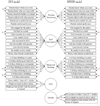Identifying social mechanisms for the prevention of adolescent drinking and driving
- PMID: 18329409
- PMCID: PMC2432526
- DOI: 10.1016/j.aap.2007.08.013
Identifying social mechanisms for the prevention of adolescent drinking and driving
Abstract
This study identifies social mechanisms that might help prevent youth from being involved in driving under the influence of alcohol (DUI) and riding with drinking drivers (RWDD). Data collected through telephone surveys with 1534 adolescents and young adults aged 15-20 years (mean=17.6, S.D.=1.6) in California, USA, were analyzed. Structural equation modeling analyses showed that DUI and RWDD were strongly related to drinking in unstructured situations, modeling of DUI by peers and parents, and perceived peer approval or disapproval of DUI. DUI outcome expectancies were indirectly related to DUI and RWDD through situational drinking. Parental monitoring and DUI law enforcement were also indirectly related to DUI and RWDD through DUI expectancies and other mechanisms. The findings, overall, suggest that parental influence remains important even through late adolescence. Parental monitoring, in particular, might help to reduce unstructured socializing with peers, drinking, and affiliation with peers who engage in DUI. Parental monitoring may also foster beliefs about the risks of DUI. Conversely, parents' own DUI behavior may normalize drinking and DUI behaviors, thus countering monitoring efforts.
Figures




References
-
- Akers RL. Deviant Behavior: A Social Learning Approach. Belmont, CA: Wadsworth; 1985.
-
- Akers RL, Lee G. A longitudinal test of social learning theory: adolescent smoking. J Drug Issues. 1996;26(2):317–343.
-
- Arnett J. The young and the reckless: adolescent reckless behavior. Current Directions in Psychological Science. 1995;4(3):67–71.
-
- Bandura A. Social Learning Theory. Englewood Cliffs, NJ: Prentice-Hall, Inc.; 1977.
Publication types
MeSH terms
Grants and funding
LinkOut - more resources
Full Text Sources
Medical

